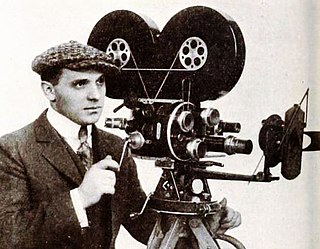
A sound film is a motion picture with synchronized sound, or sound technologically coupled to image, as opposed to a silent film. The first known public exhibition of projected sound films took place in Paris in 1900, but decades passed before sound motion pictures became commercially practical. Reliable synchronization was difficult to achieve with the early sound-on-disc systems, and amplification and recording quality were also inadequate. Innovations in sound-on-film led to the first commercial screening of short motion pictures using the technology, which took place in 1923. Before sound-on-film technology became viable, soundtracks for films were commonly played live with organs or pianos.

Rex Lloyd Lease was an American actor. He appeared in over 300 films, mainly in Poverty Row Westerns.

Kenneth Olin Maynard was an American actor and producer. He was mostly active from the 1920s to the 1940s and considered one of the biggest Western stars in Hollywood.

Frederick Alan Crosland was an American stage actor and film director. He is noted for having directed the first feature film using spoken dialogue, The Jazz Singer (1927) and the first feature movie with sychronization soundtrack, Don Juan (1926).

John Malcolm Stahl was a Russian-born American film director and producer. He is best known for his films such as Leave Her to Heaven (1945), Imitation of Life (1934), The Keys of the Kingdom (1945), and Back Street (1932).
Poverty Row is a slang term for small Hollywood studios that produced B movies from the 1920s to the 1950s, typically with much smaller budgets and lower production values than those of the major studios. Although many of these studios were based in the vicinity of Gower Street in Hollywood, the term does not necessarily relate to any specific physical location.

Robert Zigler Leonard was an American film director, actor, producer, and screenwriter.

Dorothy Revier was an American actress.

Albert S. Rogell was an American film director who was born in Oklahoma City and died in Los Angeles. Rogell directed more than a hundred movies between 1921 and 1958. He was known for an aggressive directing style, shouting at his actors and crew.

Lawrence Gray was an American actor of the 1920s and 1930s.
Samuel Sax was an American film producer. He produced 80 films between 1925 and 1946, including the last films of Roscoe Arbuckle. From 1938 to 1941, Sax headed Warner Brothers's British subsidiary at Teddington Studios in London.

Sono Art-World Wide Pictures was an American film distribution and production company in operation from 1927 to 1933. Their first feature film was The Rainbow Man (1929), while one of their most prominent was The Great Gabbo (1929) starring Erich von Stroheim and directed by James Cruze for James Cruze Productions, Inc. One of the last films distributed by the company was A Study in Scarlet (1933) starring Reginald Owen as Sherlock Holmes.

Vitaphone Varieties is a series title used for all of Warner Bros.', earliest short film "talkies" of the 1920s, initially made using the Vitaphone sound on disc process before a switch to the sound-on-film format early in the 1930s. These were the first major film studio-backed sound films, initially showcased with the 1926 synchronized scored features Don Juan and The Better 'Ole. Although independent producers like Lee de Forest's Phonofilm were successfully making sound film shorts as early as 1922, they were very limited in their distribution and their audio was generally not as loud and clear in theaters as Vitaphone's. The success of the early Vitaphone shorts, initially filmed only in New York, helped launch the sound revolution in Hollywood.
Tremlet C. Carr was an American film producer, closely associated with the low-budget filmmaking of Poverty Row. In 1931 he co-founded Monogram Pictures, which developed into one of the leading specialist producers of B pictures in Hollywood.
Maurice Henry Hoffman was an American studio owner and film producer. In the 1920s and 30s, Hoffman made films for seven different studios. He is particularly associated with Poverty Row where studios he founded -Allied Pictures, Liberty Pictures and Tiffany Pictures produced mainly low-budget B pictures.
Rayart Pictures was one of the early film production and distribution companies operating independent of the major Hollywood studios in the United States during the later silent film era from the mid-to-late 1920s and into the early "talkies" era of early films with sound in the late 1920s and early 1930s. It established its own distribution network, specializing in westerns. It was started by W. Ray Johnston in 1924, after whom the company was named. It was originally created as a low budget release agent, and like the other so-called Poverty Row studios, was based in a small plot off Sunset Strip, by Gower Street. An early Poverty Row studio, it was a forerunner of Monogram Pictures, which was also founded by W. Ray Johnston.

W. Ray Johnston was an American film producer. He was associated with low-budget filmmaking, in particular with the larger Poverty Row studios Rayart Pictures and Monogram Pictures. Before founding Rayart in 1924, he also acted in a handful of films.
Samuel Zierler (1895–1964) was an American film producer of the silent and early sound era. As well as working for various studios, in the late 1920s he controlled his own production company, Excellent Pictures. His final film work was for RKO Pictures in 1933.

Jackson Rose (1886–1956) was an American cinematographer. He shot more than a hundred and fifty short and feature films during his career. He began his career at the Chicago-based Essanay Pictures, then worked for Universal Pictures for much of the 1920s. He also shot films for a variety other studios including Tiffany Pictures, MGM, Columbia Pictures and Warner Brothers














